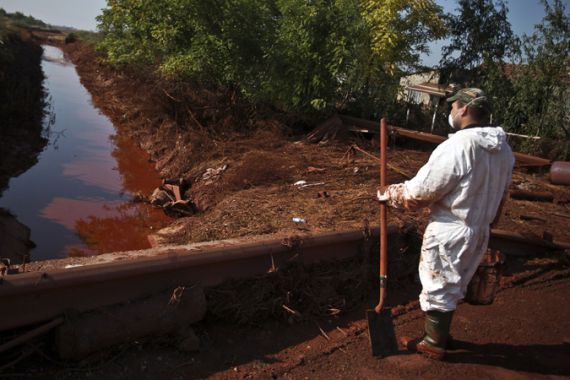Hungary moves to prevent new spill
Engineers attempt to fix cracks in reservoir holding back 2.5 million cubic metres of waste amid fears it could break.

Al Jazeera’s Anita McNaught reports from Ajka as Hungarian authorities face criticism over the sludge spill
Hundreds of engineers, emergency workers and volunteers have been working to prevent a second devastating spill of toxic red sludge from a chemical plant in Hungary.
Keep reading
list of 4 itemsCould shipping containers be the answer to Ghana’s housing crisis?
Thousands protest against over-tourism in Spain’s Canary Islands
Holding Up the Sky: Saving the Indigenous Yanomami tribe in Brazil’s Amazon
Cracks which were discovered in the wall surrounding a reservoir holding back 2.5 million cubic metres of waste were being fixed on Sunday and a series of barriers constructed to stop a repeat of last Monday’s disaster, which saw the sludge pour into three nearby villages.
“The cracks earlier noticed did not widen over Saturday and their repair is in progress,” Tibor Dobson, a spokesman for the country’s disaster agency, said.
“At the same time we are building the new dam that will protect Kolontar. The foundation work has been finished. On Sunday our major task is going to be to widen the new dyke and to build it higher.”
But Al Jazeera’s Anita McNaught, reporting from the nearby town of Ajka, said that other local officials were warning that the northern wall of the dam was still likely to fail at some point.
“We have had the under-secretary for the environment, Zoltan Illes, come out this morning and say ‘the dam cannot be saved’,” she said.
“The northern wall of the dam, that one that burst, the one that now has secondary cracks in it – that wall is going to fail sooner rather than later.”
Homes evacuated
About one million cubic metres of the waste material poured out of the alumina plant reservoir into three villages and waterways earlier this week, killing seven people, injuring 150 and fouling some rivers, including a local branch of the Danube.
About 800 people were evacuated from the town of Kolontar on Saturday after Viktor Orban, Hungary’s prime minister, said that there was a high risk of another up to 500,000 cubic metres of even thicker sludge escaping the reservoir due to a deterioration of a wall.
| In Depth | |||||||||||||
|
Most were moved to stay with friends and relatives in Ajka, but up to 30 of the evacuees spent the night in a sport’s centre in the town.
“Unfortunately we will have to stay here for a couple of nights until they build that dam. After that we can hopefully return,” one man said.
About 6,000 residents of neighbouring Devecser were told by police on Saturday to pack a single bag and get ready to leave at a moment’s notice.
Orban said the military had deployed 319 soldiers and 127 transport vehicles into the town and there were also five trains at the ready should an evacuation become necessary.
“This hasn’t changed,” Dobson, the disaster agency spokesman, said. “We are still on guard in case of any more spills.”
MAL Zrt, the company that owns the metals plant, said the waste was not considered hazardous under EU standards and recommended people clean off the sludge with water.
However, many people suffered from burns and eye irritations caused by corrosive elements in the mud.
About 46 wounded were still in hospital on Sunday, Gyorgyi Tottos, the disaster relief services spokeswoman, said.
“They don’t have life-threatening injuries, but some will need plastic surgery,” Jeno Racz, the director of the Veszprem county hospital, said.
“The most serious injuries are second- and third-degreee burns,” he told the AFP news agency. One person was in a life-threatening condition in another hospital, he said.
